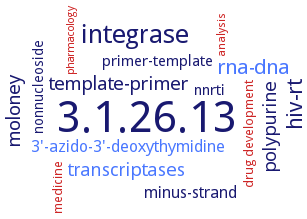Please wait a moment until all data is loaded. This message will disappear when all data is loaded.
Please wait a moment until the data is sorted. This message will disappear when the data is sorted.
2.80 A and 2.04 A resolution crystal structures of inhibitor, beta-thujaplicinol, bound at the RNase H active site of both HIV-1 RT and an isolated RNase H domain. beta-Thujaplicinol chelates two divalent metal ions at the RNase H active site
crystal structure analysis, overview. The pyrimidinol carboxylic acids is successful crystallized with Mn2+ and the isolated HIV RNase H domain
-
crystal structure of domain swapped Rnase H, overview
determination and analysis of crystal structure of enzyme mutant C280S in complex with inhibitor 6-benzyl-3-hydroxythieno[2,3-d]pyrimidine-2,4(1H,3H)-dione, PDB ID 6AOC, hanging drop vapor diffusion method, mixing of 11 mg/ml protein in 10 mM MnCl2, 5 mM tris(2-carboxyethyl)phosphine (TCEP) HCl, 0.5% beta-octylglucoside, and 1 mM 6-benzyl-3-hydroxythieno[2,3-d]pyrimidine-2,4(1H,3H)-dione in a 1:1 ratio with crystallization solution containing 15% PEG 3500, 0.1 M sodium potassium phosphate, 5% ethylene glycol, and 0.1 M Tris, pH 6.5, large, blocky crystals grow at 18°C in 2-3 days, molecular replacement using structure PDB ID 4KFB as the initial search model
-
docking simulation studies. Residue His 539 and two metal ions in the RNase H catalytic center are involved in inhibition by compounds 5-nitrofuran-2-carboxylic acid adamantan-1-carbamoyl methyl ester and 5-nitrofuran-2-carboxylic acid [[4-(4-bromophenyl)-thiazol-2-yl]-(tetrahydrofuran-2-ylmethyl)-carbamoyl]-methyl ester
-
in complex with substrate, hanging drop vapor diffusion method, using 50 mM Bis-Tris propane-HCl pH 7.0, 10% PEG 8000 (w/v), 100 mM ammonium sulfate, 5% glycerol (v/v), 5% sucrose (w/v) and 20 mM MgCl2
isolated recombinant RNase H domain, to 2.4 A resolution. The protein folds into a five-stranded mixed beta sheet flanked by an asymmetric distribution of four alpha helices. Two divalent metal cations bind in the active site surrounded by a cluster of four conserved acidic amino acid residues. The peptide bond cleaved by HIV-1 protease near the polymerase-RNase H junction of polypeptide p66 is completely inaccessible to solvent in the structure reported here, suggesting that the homodimeric p66-p66 precursor of mature RT is asymmetric with one of the two RNase H domains at least partially unfolded
-
modeling of the kinetic refolding intermediate using a C-terminal deletion fragment lacking helix E. Like the kinetic intermediate, this variant folds rapidly and shows a decrease in stability
-
purified p66/p51 HIV-1 reverse transcriptase 52A variant in complex with inhibitors manicol and TMC278, 0.0012 ml of 20 mg/mL protein in 9.2 mM Tris, pH 8.0, 68.7 mM NaCl, 3.6 mM manganese sulfate, 0.7 mM tris(2-carboxyethyl) phosphine, 0.27% w/v, beta-ocytl glucopyranoside, 7% v/v DMSO, 0.9 mM manicol, and 0.7 mM TMC278, mixed with 0.0012 ml of reservoir solution containing 50 mM HEPES pH 7.5, 100 mM ammonium sulfate, 15 mM manganese sulfate, 10 mM spermine, 5 mM TCEP, and 11% w/w PEG 8000, X-ray diffraction structure determination and analysis at 2.7 A resolution, modeling
-
purified recombinant detagged enzyme, mixing of 8-10 mg/ml protein in 20 mM potassium phosphate, pH 7.0, and 1 mM inhibitor nevirapine, with reservoir buffer containing 100 mM sodium cacodylate, pH 6.8, and 800 mM sodium citrate, in a 1:1 ratio, X-ray diffraction structure determination and analysis. Isolated RNase H domain is crystallized in a buffer containing 100 mM sodium citrate, pH 5.0, and 15 to 20% PEG-8000. Crystals are harvested for inhibitor soaking in the reservoir solution with the addition of 50 mM MnCl2, and 1 mM inhibitor nevirapine, at 4°C. Mn2+ is used as a surrogate for Mg2+ since soaking experiments with Mg2+ cannot reproducibly yield structures with inhibitor bound
purified wild-type enzyme in complex with polypurine tract RNA:DNA oligonucleotide, hanging drop vapour diffusion method, mixing of equal volumes of protein and precipitant solution, the latter contains 100 mM cacodylate, pH 5.6, 29-31% saturated ammonium sulfate, 4°C, X-ray diffraction structure determination and analysis at 3.0 A resolution, molecular replacement
solution structural dynamics. Enzyme is an asymmetric heterodimer of two subunits, p66 and p51. The two subunits have the same N-terminal sequence, with the p51 subunit lacking the C-terminal RNase H domain. The p66 subunit contains the polymerase and RNase H catalytic sites. H/D exchange indicates that the RNase H domain of p66 is very flexible
study on dynamics of RT in unliganded and inhibitor-bound forms by structure-based approach. Non-nucleoside RT inhibitors such as nevirapine interfere directly with the global hinge-bending mechanism that controls the cooperative motions of the p66 fingers and thumb subdomains. The net effect of nevirapine binding is to change the direction of domain movements rather than suppress their mobilities. The second generation non-nucleoside reverse transcriptase inhibitor, efavirenz, on the other hand, shows the stronger effect of simultaneously reorienting domain motions and obstructing the p66 thumb fluctuations. A second hinge site controlling the global rotational reorientations of the RNase H domain is identified
-
HIV-1 reverse transcriptase mutant form RT52A in complex with rilpivirine and an RNase H inhibitor XZ462, hanging drop vapor diffusion method, the crystallization solution contains 10% PEG 8000, 50 mM imidazole, pH 6.8, 10 mM spermine, 15 mM MgSO4, and 100 mM (NH4)2SO4, crystals of the RT-rilpivirine (RPV) complex are soaked for 30 min with 2 mM compound XZ462 in the crystallization solution in presence of 15 mM MgSO4, X-ray diffraction structure determination and analysis at 1.51-2.2 A resolution, molecular replacement using the 1.51 A resolution structure of the HIV-1 RT-rilpivirine complex (PDB ID 4G1Q) as template
Human immunodeficiency virus type 1 group M subtype B




 results (
results ( results (
results ( top
top





